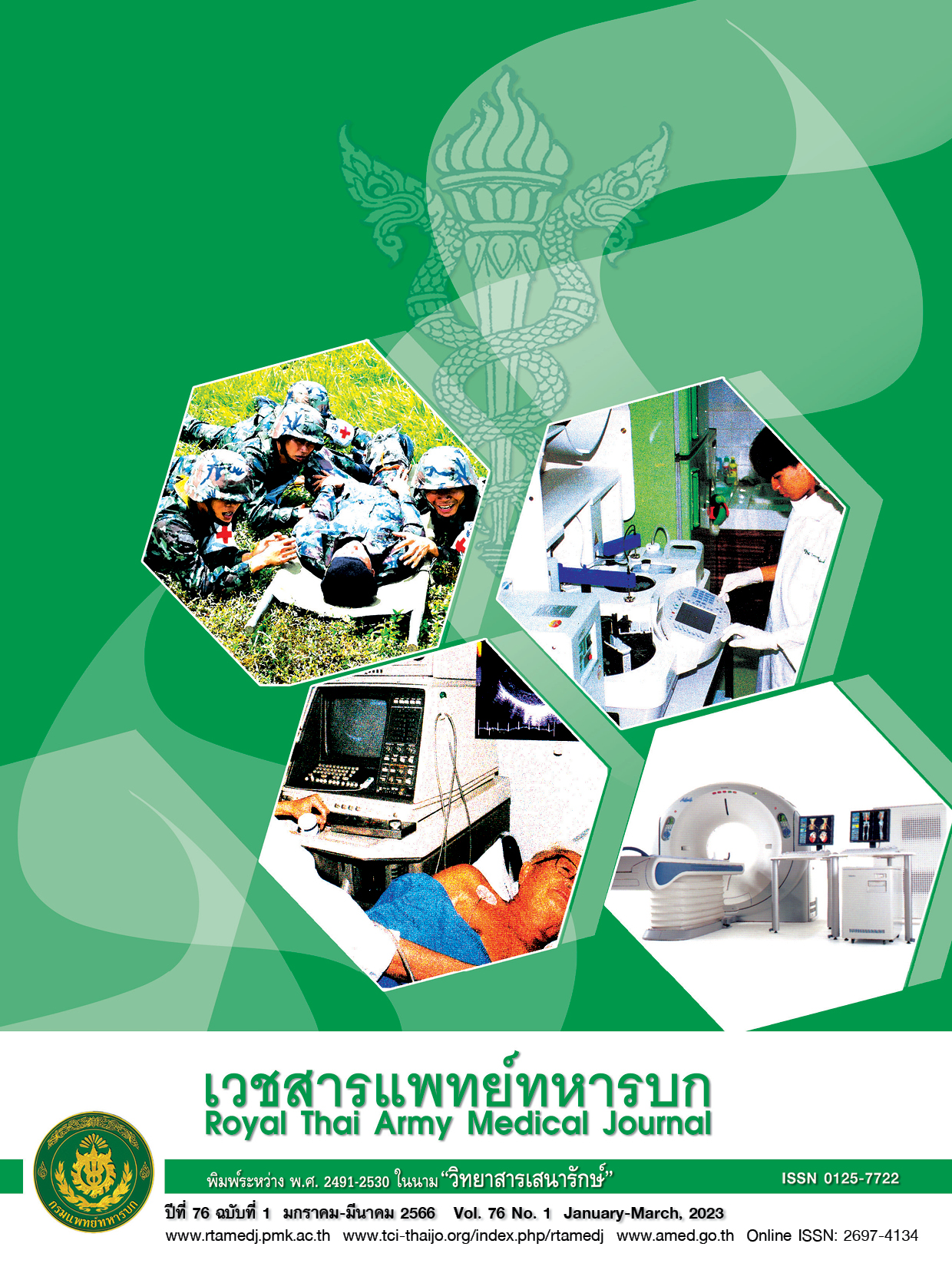การติดเชื้อที่สัมพันธ์กับการล้างไตทางช่องท้อง และตัวชี้วัดดัชนีที่สำคัญในผู้ป่วย ล้างไตทางช่องท้องในผู้ป่วยล้างไตทางช่องท้องแบบถาวร
Main Article Content
บทคัดย่อ
บทนำ การล้างไตทางช่องท้องเป็นหนึ่งในการรักษาผู้ป่วยโรคไตเรื้อรังระยะสุดท้าย ขณะที่การติดเชื้อที่สัมพันธ์กับการล้างไตทางช่อง ท้องเป็นสาเหตุสำคัญของการเจ็บป่วยและการเสียชีวิต การศึกษานี้เป็นการหาความชุก และระบาดวิทยาของการติดเชื้อที่สัมพันธ์กับ การล้างไตทางช่องท้อง รวมถึงตัวชี้วัดดัชนีที่สำคัญในผู้ป่วยล้างไตทางช่องท้อง วิธีการศึกษา เป็นการศึกษาแบบเก็บข้อมูลไปข้างหน้า ใช้แบบฟอร์มบันทึกข้อมูลผู้ป่วย และข้อมูลจากเวชระเบียนของผู้ป่วยล้างไตทางช่องท้อง เพื่อศึกษาถึงเชื้อก่อโรค ปัจจัยเสี่ยง และผลการรักษา รวมถึงตัวชี้วัดดัชนีที่สำคัญในผู้ป่วยล้างไตทางช่องท้อง ผลการศึกษา ผู้ป่วยล้างไตทางช่องท้อง 304 ราย ภาวะเยื่อบุช่องท้องอักเสบจากการติดเชื้อที่สัมพันธ์กับการล้างไตทางช่องท้อง (PD-related peritonitis) ที่เพาะเชื้อไม่ขึ้นได้ร้อยละ 26.1 อัตราการเกิดการติดเชื้อที่ปากแผลในรอบ 1 ปี ได้จำนวน 0.07 ครั้งต่อราย-ปี, อัตราการเกิด PD-related peritonitis ในรอบ 1 ปี ได้ 0.35 ครั้งต่อ ราย-ปี ภาวะ PD-related peritonitis มีสาเหตุจากการที่เชื้อจุลชีพแพร่ผ่านช่องท้องโดยผ่านทางสายล้างช่องท้องพบมากที่สุดร้อยละ 31.5 ผลการเพาะเชื้อจุลชีพจากน้ำล้างไตในภาวะ PD-related peritonitis ส่วนใหญ่เป็นเชื้อแบคทีเรียแกรมบวกร้อยละ 38 การตอบ สนองต่อการรักษาภาวะ PD-related peritonitis พบการตอบสนองต่อการรักษาดีช่วงแรกร้อยละ 66.3 สำหรับ peritonitis-related death พบร้อยละ 7.6 ปัจจัยเสี่ยงที่สัมพันธ์ต่อการเกิดภาวะ PD-related peritonitis อย่างมีนัยสำคัญทางสถิติคือ การลดลงของระดับยูเรีย อัลบูมิน โซเดียม และแคลเซียมในเลือด ภาวะ PD-related peritonitis ที่เกิดจากการติดเชื้อราสัมพันธ์กับการเพิ่มความเสี่ยงต่อความล้มเหลวในการรักษาอย่างมีนัยสำคัญทางสถิติ สรุป จากการศึกษานี้พบดัชนีชี้วัดคุณภาพและเป้าหมายของการปฏิบัติ งานสำหรับการทำล้างไตทางช่องท้องโรงพยาบาลพระนครศรีอยุธยาได้ตามเกณฑ์มาตรฐานของสมาคมโรคไตแห่งประเทศไทย จุลชีพที่เป็นสาเหตุหลักของภาวะ PD-related peritonitis ยังเป็นแบคทีเรียแกรมบวก PD-related peritonitis ที่เกิดจากการติดเชื้อรา สัมพันธ์กับการเพิ่มความเสี่ยงต่อความล้มเหลวในการรักษา
Downloads
Article Details

อนุญาตภายใต้เงื่อนไข Creative Commons Attribution-NonCommercial-NoDerivatives 4.0 International License.
บทความในวารสารนี้อยู่ภายใต้ลิขสิทธิ์ของ กรมแพทย์ทหารบก และเผยแพร่ภายใต้สัญญาอนุญาต Creative Commons Attribution-NonCommercial-NoDerivatives 4.0 International (CC BY-NC-ND 4.0)
ท่านสามารถอ่านและใช้งานเพื่อวัตถุประสงค์ทางการศึกษา และทางวิชาการ เช่น การสอน การวิจัย หรือการอ้างอิง โดยต้องให้เครดิตอย่างเหมาะสมแก่ผู้เขียนและวารสาร
ห้ามใช้หรือแก้ไขบทความโดยไม่ได้รับอนุญาต
ข้อความที่ปรากฏในบทความเป็นความคิดเห็นของผู้เขียนเท่านั้น
ผู้เขียนเป็นผู้รับผิดชอบต่อเนื้อหาและความถูกต้องของบทความของตนอย่างเต็มที่
การนำบทความไปเผยแพร่ซ้ำในรูปแบบสาธารณะอื่นใด ต้องได้รับอนุญาตจากวารสาร
เอกสารอ้างอิง
The Nephrology Society of Thailand. Thailand Renal Replacement Therapy Year 2020. [Internet]. Bangkok: The Nephrology Society of Thailand;2020 [cited 2023 Mar 5]. Available from : https://www.nephrothai.org/wp-content/uploads/2022/06/FinalTRT-report-2020.pdf
Thai 2. Szeto CC, Li PK, Johnson DW, Bernardini J, Dong J, Figueiredo AE, et al. ISPD Catheter-Related Infection Recommendations: 2017 Update. Perit Dial Int. 2017;37(2):141-54.
Li PK, Szeto CC, Piraino B, de Arteaga J, Fan S, Figueiredo AE, et al. ISPD Peritonitis Recommendations: 2016 Update on Prevention and Treatment. Perit Dial Int. 2016;36(5):481-508.
Teitelbaum I. Peritoneal Dialysis. N Engl J Med. 2021;385(19): 1786-95.
Kanjanabuch T. [Clinical Practice Guideline (CPG) for Peritoneal Dialysis 2017]. Bangkok: The Nephrology Society of Thailand; 2017. Thai
Li PK, Chow KM, Cho Y, Fan S, Figueiredo AE, Harris T, et al. ISPD peritonitis guideline recommendations: 2022 update on prevention and treatment. Perit Dial Int. 2022;42(2):110-53.
Valeri AM, Robbins-Juarez SY, Stevens JS, Ahn W, Rao MK, Radhakrishnan J, et al. Presentation and Outcomes of Patients with ESKD and COVID-19. J Am Soc Nephrol. 2020;31(7):1409- 15.
Lambie M, Zhao J, McCullough K, Davies SJ, Kawanishi H, Johnson DW, et al. PDOPPS Steering Committee. Variation in Peritoneal Dialysis Time on Therapy by Country: Results from the Peritoneal Dialysis Outcomes and Practice Patterns Study. Clin J Am Soc Nephrol. 2022;17(6):861-71.
Luvira V, Satirapoj B, Supasyndh O, Chaiprasert A, Ruangkanchanasetr P, Nata N, et al. A single-centre experience: peritoneal dialysis-related infections in patients on long-term dialysis. J Med Assoc Thai. 2011;94(Suppl 4):S30-6.
Ruengorn C, Panyathong S, Dandecha P. [Peritoneal Dialysis Patients Care: Treatment, Surveillance, and Prevention of Peritoneal Dialysis-Related Infection Using Evidence-Based]. Bangkok: Health Systems Research Institute and National Research Council of Thailand; 2017. Thai
Tiawilai T, Tantivichitvej R. [The Incidence and Risk Factors of First Peritonitis Episode in Continuous Ambulatory Peritoneal Dialysis Patients of Photharam Hospital]. Region 4-5 Medical Journal. 2020;39(1):51-64. Thai
Jitraknatee J. [The result of peritoneal dialysis in Fang Hospital]. Lanna Public Health Journal. 2015:8-17. Thai
Brown EA, Blake PG, Boudville N, Davies S, de Arteaga J, Dong J, et al. International Society for Peritoneal Dialysis practice recommendations: Prescribing high-quality goal-directed peritoneal dialysis. Perit Dial Int. 2020;40(3):244-53.
Natejumnong C, Jitthorn K, Naka P, Noithachang W, Mekla N, Chaiprasert A. Increasing cases of filamentous fungal peritonitis complicating peritoneal dialysis : Case series in Uttaradit Hospital Thailand. Journal of the Nephrology Society of Thailand.


